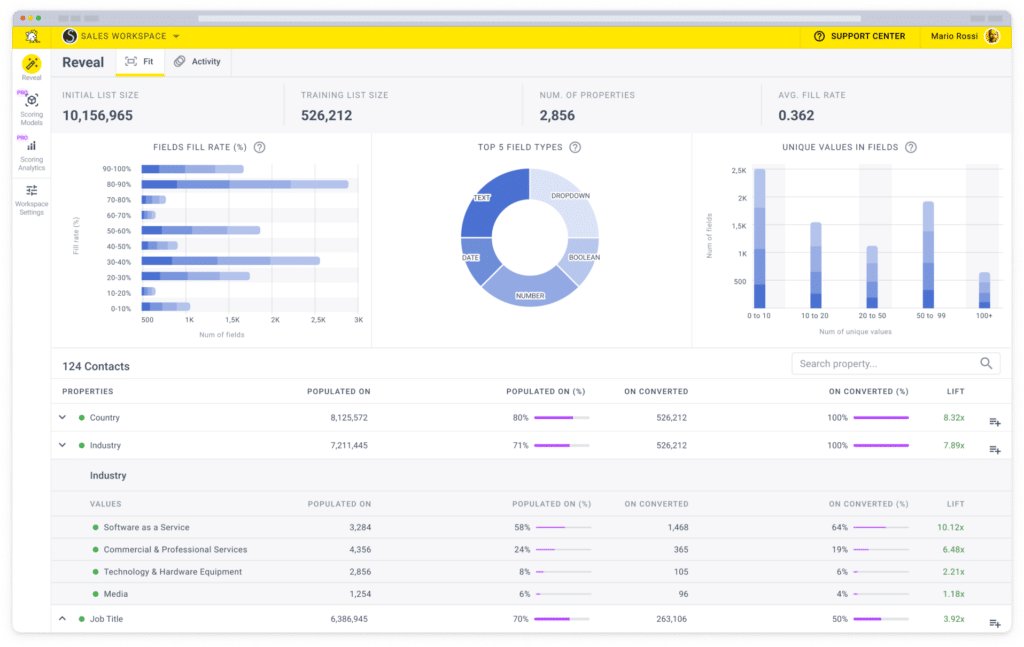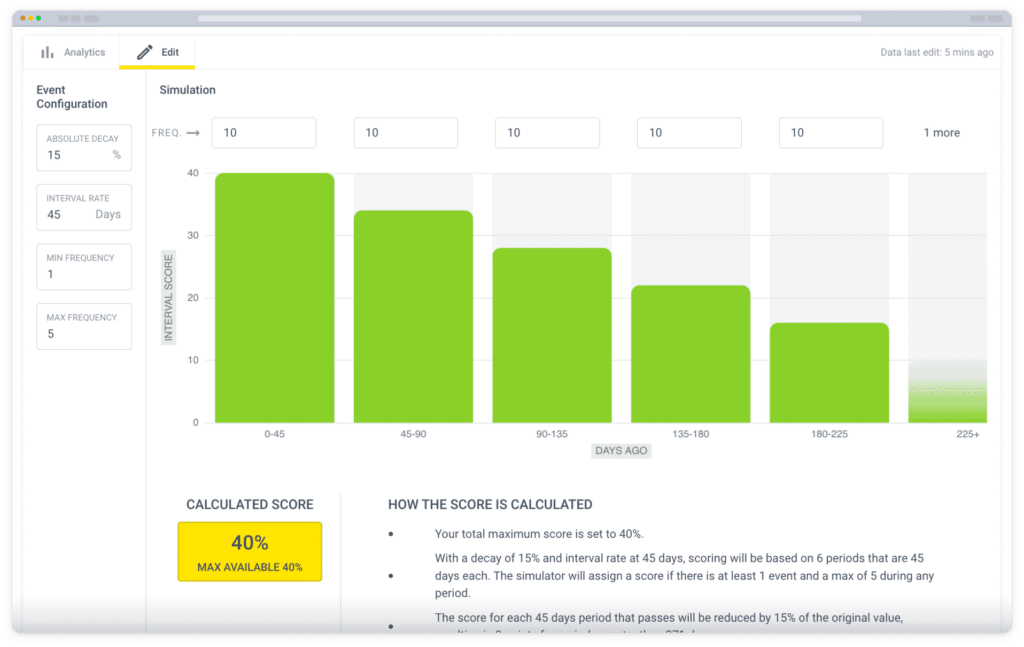Businesses that adopt product-led growth (PLG) enjoy 60% higher average revenue per user than non-PLG brands.
Are you considering this model to improve customer retention? To ensure business success in your product-led growth (PLG) motion, you must be able to assess its impact.
Doing so will help you keep cross-functional teams working towards the same goal and drive decision-making as you focus on more effective strategies.
You can use product growth metrics to build a lead scoring model with Breadcrumb’s platform.
In this blog, we’ll talk about key product metrics to help you reach and exceed your growth and retention-related goals. Then, we’ll show how Breadcrumbs can help support your PLG motion.
The Role of Product Metrics in a PLG Motion
Before we get into why product metrics are so important, we must first understand the reason behind adopting a product-led growth strategy in the first place.
When you think about it, the primary reason a customer purchases from a business is the value they’re getting. And they get this value from a product or service.
Without it, the company more than likely wouldn’t exist.
So, focusing on the product as the primary driver of customer acquisition, retention, and expansion is a viable strategy.
When you put your product at the forefront, it can lead to lower customer acquisition costs, more revenue growth, and increased customer loyalty.
This is why a PLG motion exists in 58% of organizations, as per recent research.
What does a successful PLG strategy look like? It involves taking a user-centric approach, providing a seamless onboarding experience, and offering value to customers.
To truly measure the success of this strategy, you must track metrics. Otherwise, you won’t get the data you need to make more informed decisions about improving or refining your PLG model.
Let’s look at an example.
In a dispensary business, product metrics might include factors such as sales volume, customer engagement, inventory turnover, and product popularity.
Understanding which products drive sales and resonate with customers allows the dispensary to optimize inventory, tailor marketing efforts, and enhance the overall customer experience.
That’s why the best dispensary business plans include a section on product metrics, as it ensures a data-driven approach to product management, contributing to informed decision-making and the sustained success of the dispensary in a competitive market.
The gaming industry also offers a compelling example, particularly with popular online games like Fortnite and bonus downloadable content like the Catwoman Pickaxe. Games like this have successfully used the power of in-game items and features to drive user engagement and retention.
For instance, Catwoman’s Grappling Claw Pickaxe, a sought-after item, enhances the gaming experience, and its purchase is a key metric for monitoring player involvement and purchase behavior. Players who purchase it are more likely to also purchase other popular Fornite items like the Batman Zero Wing Glider and the Batman Who Laughs skin.
Similarly, you can apply these insights by tracking metrics such as feature adoption rates, user engagement levels, and conversion rates.
This approach enables you to understand the real value of your products and refine your strategies for better user experience and growth.
By focusing on what users truly value, you can create a cycle of continuous improvement and customer satisfaction, which is at the heart of successful PLG strategies.
Key Product Metrics for Customer Acquisition in a PLG Motion
Now that you understand why monitoring metrics is critical for PLG motion, let’s look at some of the most popular ones to look at for better decision-making and sustained growth.
1. User Engagement
Because PLG is a user-centric approach, user engagement is one of the most important to consider.
It measures how engaged users are with your product, helping you identify potential points of friction.
As a result, you can create a product adoption experience that focuses on creating value for the customer.
User engagement is pretty broad, so there are quite a few metrics that fall under it:
- Active users: Measures how many users actively interact with your product. You can measure this by monthly active users (MAU), weekly active users (WAU), or daily active users (DAU).
- Product onboarding engagement rate: Measures the percentage of individuals who actively participate in the onboarding process.
- Trial to paid conversion rate: Measures the percentage of leads who use your free trial and purchase the full subscription.
- Session duration: Measures the average time a user spends engaging with your product within one session.
- Feature adoption rate: Measures the level of user interaction and usage of specific functionalities in your product.
2. Retention Rate
The retention rate represents how much recurring revenue you generate from existing customers—including downgrades and churn.
This metric gives insights into the stickiness of your product, which means how satisfied customers are with the user experience and other factors that drive loyalty.
3. Churn Rate
Churn rate is a product metric that measures the rate at which customers stop using your product and never return.
This may happen for a number of reasons:
- A customer realizes their changing needs don’t match your product.
- A customer doesn’t find value in your solution.
- A customer is unhappy with your product.
- A customer finds a different solution.
Here’s the formula for churn rate:
The number of lost customers divided by the total number of customers times 100
4. Conversion Rate
Your conversion rate is the percentage of users who make it from one step to the next in the b2c or b2b sales funnel.
One path may be from your product page to the checkout page. Or, it could be from a new customer (signing up for a paid subscription) to a repeat customer (paying the subscription every month).
Calculate the conversion rate by dividing the total number of users in the latter stage (repeat customer) by the total number of users in the previous stage (new customer).
Creating Lead Scoring Models with Product Metrics
With these metrics in mind, here’s how to uncover the best lead scoring model for your business.
The Role of Lead-Scoring Tools like Breadcrumbs
Product metrics don’t just inform your product strategy. They can also help you score your leads more accurately and effectively.
Breadcrumbs is a tool that allows you to build a lead-scoring model in just a few clicks.
How Breadcrumbs Uses Product Metrics to Create Lead Scoring Models
When you use Breadcrumbs for your PLG strategy, you can upload your data, including product metrics, to our platform.
From there, you can create a lead scoring model using data from demographics, online activity, and how users interact with your product.
The best part? Reveal uncovers the secrets of your high-value contacts and accounts. You can instantly get valuable insights into your buyer persona, including firmographic data and online behavior (i.e., download a white paper).
As a result, you’ll be able to score leads based on their engagement levels and potential for conversion.
That way, you can focus your resources and time on potential customers who are most likely to convert.
Leveraging Breadcrumbs to Identify Free Users Ready for a Sales Pitch
Are you sick of wasting time and resources on leads that aren’t worthy of your sales pitch? You’ve come to the right place. Let’s take a look at how Breadcrumbs can solve that pain point.
An Overview of Breadcrumbs in a PLG Motion
When creating a lead scoring model with Breadcrumbs, you’ll be able to assign scores to leads, which represent how likely they are to convert.
This process will help your sales team identify high-intent leads so that they can create opportunities to upsell, cross-sell, and prevent churn.
Our platform offers integrations for a wide range of marketing automation tools, CRMs, and product analytics tools, which helps you visualize your data all in one place.
Using Breadcrumbs to Identify Potential Customers
Breadcrumbs give you insights into whether a user is ready for a sales pitch. It does this by analyzing various lead scoring criteria like a lead’s engagement, behaviors, and interaction with your company’s product or service.
To get started, you must define key engagement metrics and integrate your marketing automation, CRM, or product analytics tools with the Breadcrumbs platform.
Key metrics might include features customers use, the time they spend using your product, or specific actions they take.
Then, assign lead scores based on user behavior. Our tool will give higher scores to free users who show behaviors that indicate a higher likelihood of conversion.
Using this data, you can create tailored sales pitches that demonstrate your product’s ability to align with a user’s demonstrated interests, needs, and pain points.
Conclusion: Driving Business Success with Product Metrics and PLG
And that’s all there is to it. A one-stop-shop guide to all the product metrics you should track when jumping on the product-led growth bandwagon.
Recap of Key Product Metrics and Tools
91% of companies plan to increase their product-led growth investment. Gartner predicts that by 2025, 75% of SaaS providers will implement PLG to grow and expand their customer base.
Will you be one of them?
PLG is about giving users the opportunity to try out your product and let its worth speak for itself during their initial interaction.
But you won’t know how well your strategy is achieving this without measuring it first.
Metrics like user engagement, retention rate, churn rate, and conversion rate can help you uncover strengths and areas of weakness in your PLG motion.
The Importance of Regular Monitoring and Analysis in a PLG Motion
Regularly analyzing product metrics is key to continued success. User preferences and needs change, so continuous monitoring is key.
Using a lead scoring tool like Breadcrumbs, you can assess and prioritize leads based on their engagement and behavior within your product.
So, start tracking key product metrics today and consider adopting Breadcrumbs for your lead scoring needs. Book your free demo today.






